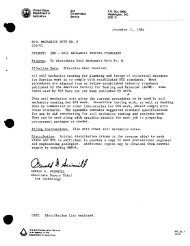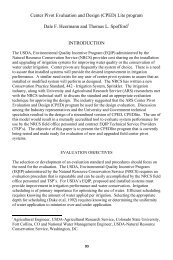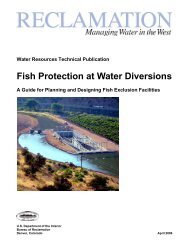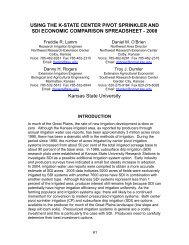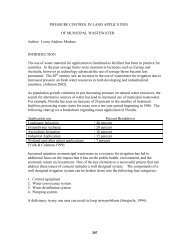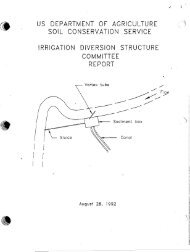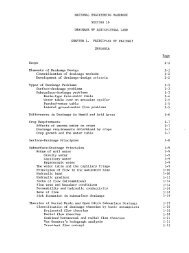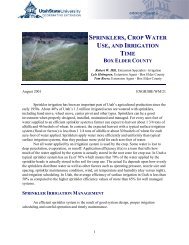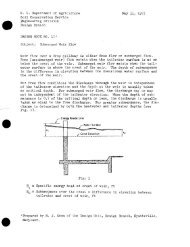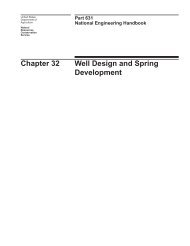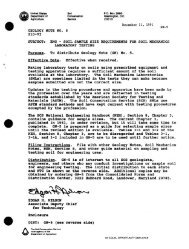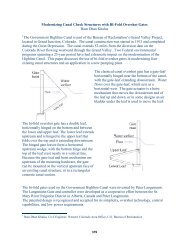Chapter 11: Sprinkle Irrigation - NRCS Irrigation ToolBox Home Page
Chapter 11: Sprinkle Irrigation - NRCS Irrigation ToolBox Home Page
Chapter 11: Sprinkle Irrigation - NRCS Irrigation ToolBox Home Page
Create successful ePaper yourself
Turn your PDF publications into a flip-book with our unique Google optimized e-Paper software.
Alfalfa<br />
453 X 50 X 4.3 = 609<br />
Q =<br />
10 X 16<br />
Total for July = 898 gpm<br />
Although only two of the three crops are being<br />
irrigated, the maximum capacity requirement of<br />
the system is in July.<br />
The quality of most water is good enough that no<br />
extra system capacity is required for leaching during<br />
the peak use period. Leaching requirements can<br />
usually be adequately satisfied before and after the<br />
peak use-period.<br />
If highly saline irrigation water is to be used on<br />
salt sensitive crops (when the conductivity of the irrigation<br />
water is more than half the allowable conductivity<br />
of the drainage water), it is advisable to<br />
provide a portion of the annual leaching requirement<br />
at each irrigation. Thus, the system capacity<br />
should be increased by an amount equal to the annual<br />
leaching requirement divided by the number of<br />
irrigations per year. The procedure for determining<br />
leaching requirements is presented in Technical Release<br />
No. 21.<br />
It is not wise to irrigate under extremely windy<br />
conditions, because of poor uniformity and excessive<br />
drift and evaporation losses. This is especially<br />
true with periodic-move systems on low infiltration<br />
soils that require low application rates. When these<br />
conditions exist, system capacities must be increased<br />
proportionately to offset the reduced number<br />
of sprinkling hours per day.<br />
In water-short areas, it is sometimes practical to<br />
purposely underirrigate to conserve water at the expense<br />
of some reduction in potential yields. Yields<br />
per unit of water applied often are optimum with<br />
system capacities about 20 percent lower than are<br />
specified for conventional periodic-move systems in<br />
the same area. Underirrigation is best achieved by<br />
using a longer interval between irrigations than is<br />
normally recommended for optimum yields.<br />
Fixed Systems<br />
Fixed systems can be used for ordinary irrigation,<br />
high frequency irrigation, crop cooling, and frost<br />
protection. Special consideration is required when<br />
estimating the system capacity required by each of<br />
these uses. All fixed systems are ideal for applying<br />
water-soluble fertilizers and other chemicals.<br />
Ordhary <strong>Irrigation</strong>*- Some fixed syeterns are installed<br />
irl permanent crops, and relatively long irrigation<br />
intervals are used. The capacity of such systems<br />
can be 5 to 10 percent less than conventional<br />
periodic-move systems in the same area because<br />
there is no down time during lateral moves. The capacity<br />
should be sufficient to apply the peak "net"<br />
crop water requirements for low frequency (1- or 2-<br />
week interval) irrigations when the system is operated<br />
on a 24-hr day, 7-day week bssis. These syatems<br />
may be used to apply ferkilizers and other<br />
chemicals and can be controlled by hand valves.<br />
High Frequency.-If the system is designed to<br />
apply irrigations once or twice a day to control soil<br />
temperatures and to hold the soil moisture content<br />
within a narrow band, a greater system capacity is<br />
required. The net system capacity should be increased<br />
hy 10 to 20 percent over a conveiltiond<br />
periodic-move system because the crop will dways<br />
be consuming water at the peak potential evapotranspiration<br />
rate. By contrast, under lower fr9-<br />
quency irrigation, as the soil moisture decreases the<br />
consumptive use rate falls below the peak pdtential<br />
rate. A major purpose for such a system is to keep<br />
the crop performing at a peak rate to incresse quelity<br />
and yield. Clearly, crops that do not respond<br />
favorably to uniform high soil moisture conditi~~s<br />
are not particularly good candidates for solid set<br />
systems. High frequency systems can be hand<br />
valve operated. However, automatic valve systems<br />
can be used to apply fertilizers and chemicals.<br />
Crop Cooling.-Very high frequency systems<br />
used for foliar cooling must have antomatic valving,<br />
use high qudity water, and have uy: to double the<br />
capacity of ordinary high frequency systems. Foliar<br />
cooling systems are sequenced so that the leaves<br />
ate kept wet. Water is applied until the leaf surfaces<br />
are saturated, shut off untii they are nearly<br />
dry, then reapplied. This generally requires having<br />
<strong>11</strong>4 to <strong>11</strong>6 of the systam in operation simultaneously<br />
and cycling the system once every 15 to 40 min depending<br />
on system capacity, crop size, and climatic<br />
conditions. For example, a system for ccoling trees<br />
might be operated 6 ou!: of every 30 min so that <strong>11</strong>5<br />
of the area is being sprinkled at any one time,<br />
Foliar cooling systems must have sufficient capacity<br />
to satisfy the evaporation demand on a minuteby-minute<br />
basis throughout the peak use hours during<br />
the peak use days. To accori~plish this, the system<br />
capacity must be 1.5 to 2.5 times as great as is<br />
required for a conventional periodic-move system.



